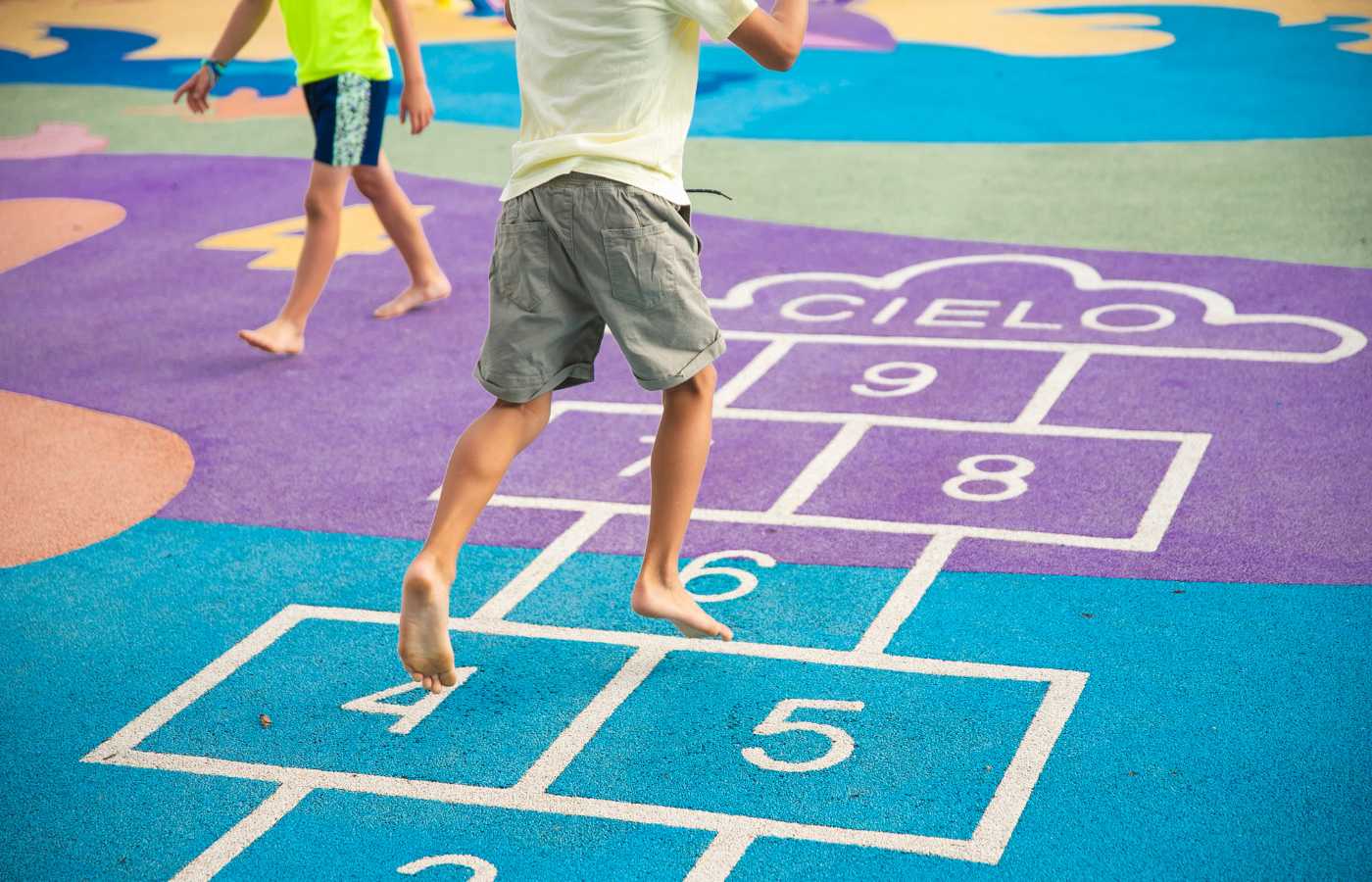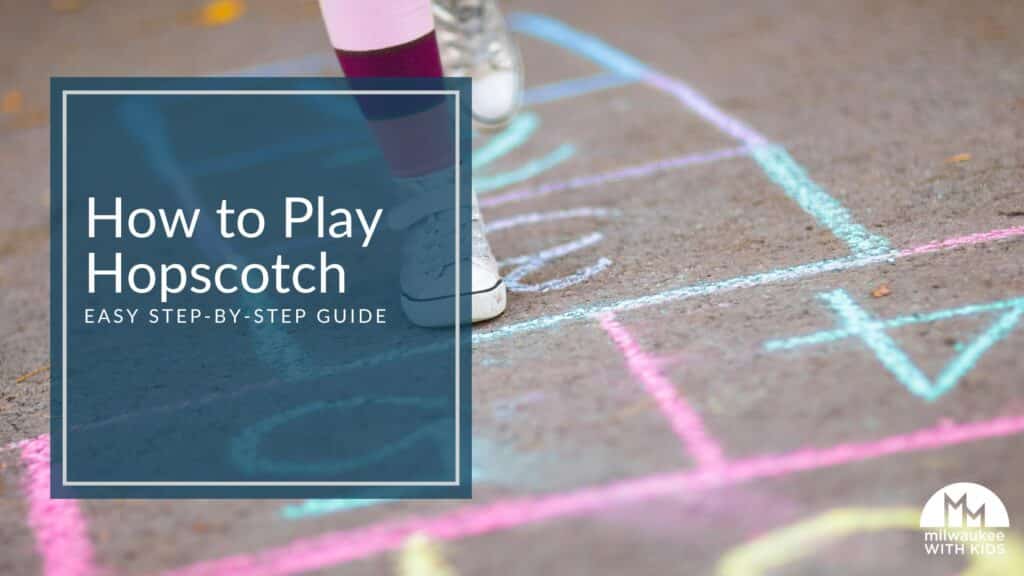
Hopscotch is a classic children’s game that has been enjoyed for generations. With its simple rules and minimal equipment requirements, it’s a popular pastime for kids all around the world.
In fact, you might remember playing it as a child back in the day!
But do you remember the actual rules? I’ll show you how to draw the hopscotch court and give you a step-by-step guide to how to play Hopscotch.
We’ll also dig a little deeper and offer fun variations that your kids can try playing today, the fascinating history of hopscotch, and the many physical and cognitive benefits it can offer to kids of all ages. Let’s dive in!
Looking for more screen-free activities for bored kids? Check out our list of 100 boredom buster activities, and more fun sidewalk chalk activities your kids will love.
Basic Rules of Hopscotch
Do you want to know how to play Hopscotch the right way? In my experience, following the basic hopscotch rules is not difficult.
Turns out, it’s the simplicity of the game that has made it so popular over the years. Even younger children can catch easily with a little practice.

Here are the rules:
- Each player takes turns tossing a small object (small stone, bean bag, small rock, bottle cap, etc.) into the first square of the hopscotch grid. If it lands in the wrong square, outside the square or on the line, the player loses their turn.
- The player must then hop on one foot to the first square, then to the second square, and so on, until they reach the square with the object in it.
- When they reach the square with the object, the player must pick it up and hop back to the starting square, skipping the square with the object.
- If the player completes the round without stepping on the lines or losing their balance, they get to toss the object into the next square and repeat the process.
- If the player makes an error or loses their balance, their turn is over and the next player gets a turn.
- The game continues until all players have had a turn, or until someone makes it to the highest numbered square.
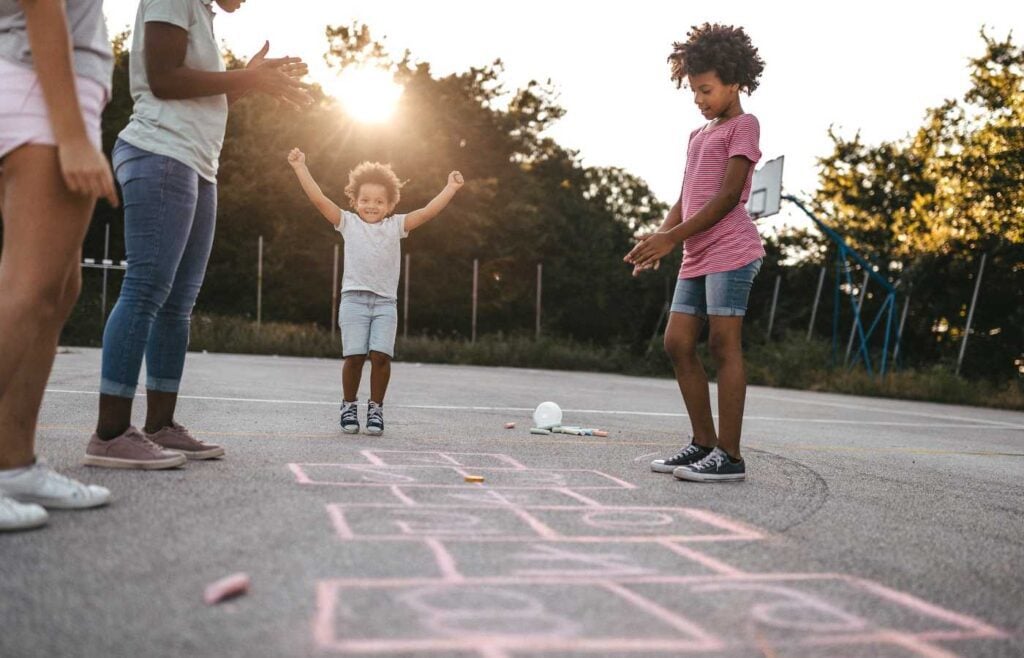
The “winner” can be the player who completes the game with the fewest errors or in the shortest amount of time.
However, in Hopscotch, there is no official “winner” as it is typically played as a solo activity or as a cooperative game. The objective of the game is to successfully complete the course without stepping on the lines or losing balance.
Players may challenge themselves to complete the course faster or with more complex variations, but ultimately the goal is to have fun and improve one’s skills.
Pro Tip: It helps if the rock you use is a flat stone rather than round and bumpy.
How To Draw A Hopscotch Board
The first thing you’ll need for this fun outdoor game is a Hopscotch board. You’ll need to draw or create a traditional hopscotch court like the one pictured below. If you’re outside, use chalk (sidewalk chalk is the best kind to use). If you’re inside, you can delineate the hopscotch pattern with masking tape or painter’s tape.

The hopscotch design pictured above is the traditional version, but you can find other hopscotch diagrams online, or get creative and come up with you own.
First, draw a large half circle shape at the top of the grid with a number ten inside. Next, connect a number square coming off the middle of the half moon with a nine drawn inside. From there, you draw two side squares that are wider than the nine with seven drawn in the left square and eight drawn inside the right square.
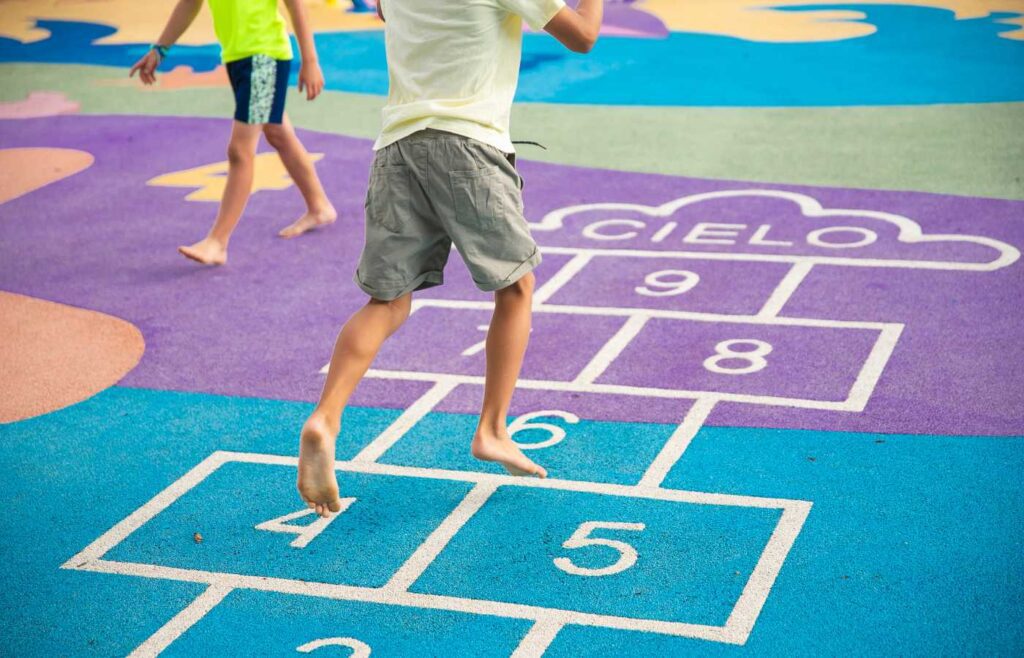
You repeat the pattern for the next set of squares.
The next square – the six box – is a single square, and the five and four boxes are double squares side by side.
For the last three boxes, you draw just one square (with no square next to it) for three, two, and on.
(Some variations of this grid have the one and two boxes side by side as single squares.)
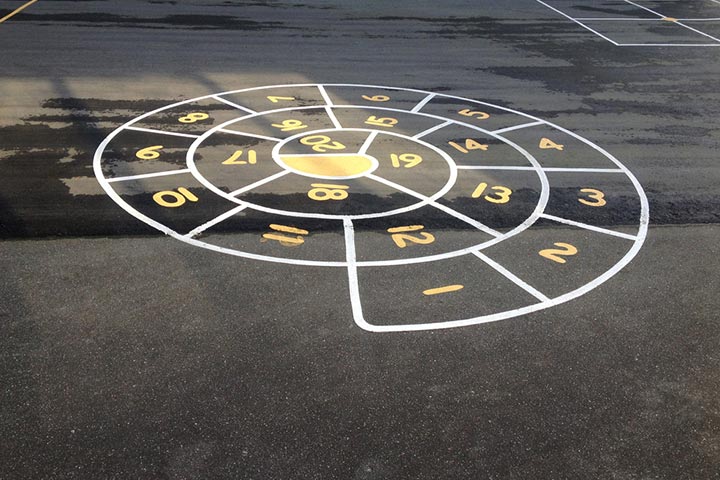
You can also create a spiral court, like the one pictured above.
No matter what design of the court you choose, the basic rules will stay the same.
If you’re inside, you can delineate the hopscotch pattern with masking tape, painter’s tape, electrical tape, or duct tape.
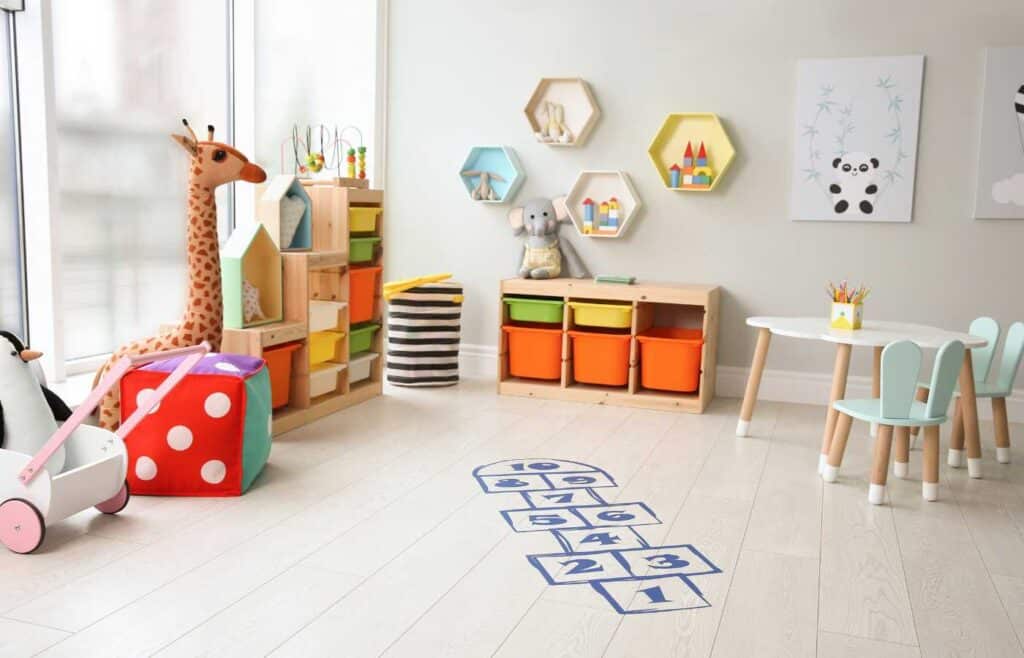
Now that you’ve created your Hopscotch Court, you’re ready to play!
Hopscotch Variations
If you’ve mastered the traditional way to pay, you can easily spice things up a little.
Try one of these amazing hopscotch variations, each with their own set of rules. Or try to come up with you own version of the game!
1. Random Toss
Instead of going in order of the numbered squares, toss the small rock and see where it lands.
2. Timed runs
Set the timer for 30 seconds (or some other interval that works best for you). Each player must complete the course within the time frame. If you go over the time limit, you lose your turn. This is a great game for really competitive kids.
3. Can You Kick It?
For a fun twist, try kicking the marker from one space to the next with your hopping foot as you make your way through the course.
4. Categories
Label each hopscotch square with the name of a category (animals, ice cream flavors, pizza toppings, movies, books, etc.).

When a player hops into a square, they must shout an item in its designated category. You lose your turn if you can’t think of an item in that category, or if you repeat another player’s item.
5. Rearrange the Squares
Switch up the traditional hopscotch course. Search for new ideas online, or brainstorm new courses yourself.
6. Obstacle Course
With a little creativity, you can leave up your hopscotch course in a major way. Create rules on your grid like “hop back”, “jump twice”, “spin”, etc. to make your hopscotch game feel like a fun board game that has come alive.
Benefits of Hopscotch
This classic and simple game is much more than meets than eye. Besides being a whole lot of fun, Hopscotch offers a whole host of benefits to its players. It especially helps young kids to:
Increase Physical Activity
Kids will increase physical activity as they engage in this active hopping game.
Master Body Control
As they switch from one foot to the other, trying to stay within the hopscotch grid, they will gradually learn to control their own body more effectively and improve their physical agility.
Manage Body Rhythm
Good hopscotch players manager their body rhythm well as they hop from one square to the next.
Build Balance
Hopping on one foot requires balance and core strength, so hopscotch is a great way to build these skills.
Strengthen Hand/Eye Coordination
Throwing the rock into a square is a good way to help build hand-eye coordination.
Build Social Skills
Hopscotch is a social game that you play with others, so your child will build social skills while they are having fun.
History of Hopscotch
Scholars believe that everyone’s favorite playground game may actually be more than one thousand years old, originating in ancient Britain. It’s believed to have begun during the early Roman Empire, when the hopscotch courts were used for military training exercises and were over one hundred feet long. Roman soldiers would run the full course while dressed in their full armor.
Roman children began imitating them and developing a scoring system to turn it into a game. Sometimes you might see the world “London” written at the top of a Hopscotch court. It’s a reminder of the Roman Road, the “Great North Road” which is a 400 miles road used by the Roman military that stretched from Glasgow to London.
F.A.Q.
Each player tosses a small object into a square, hops through the course on one foot, picks up the object, and hops back. Avoid stepping on lines or losing balance.
Use chalk outdoors or tape indoors to draw a traditional court with numbered squares. You can also create spiral or custom designs for variety.
Try timed runs, random toss, kicking the marker, or adding categories to each square. You can also design obstacle courses with special rules.
Hopscotch improves balance, coordination, physical activity, rhythm, body control, and social skills while keeping kids entertained.
Hopscotch dates back over 1,000 years to ancient Rome, where soldiers used long hopscotch courts for military training. Children later adapted it into a game.
for
Yes! Use painter’s tape or masking tape to create an indoor hopscotch grid on your floor. It’s a perfect rainy-day activity.
Chalk or tape to draw the court, a small object like a rock or bean bag as a marker, and an open space to hop safely.
So, there you have it! We hope you have enjoyed learning the official rules and variations of this fun game. Whether you play indoor hopscotch or enjoy an easy outdoor game, you can keep your kids active all year long.
The next time the kids are bored, whining, and don’t know what to do, start up a simple game of hopscotch and win the day!
We’d love to see pictures of you and your family playing. Tag us (@mkewithkids) or email us at hello@mkewithkids.com. You might show up on our social media!
Related Posts:
100 Best Play Date Ideas for Kids & Toddlers
Calie Herbst, Editor-in-Chief of Milwaukee With Kids, has spent over a decade combining her experiences as a parent of three to create a hub for Milwaukee’s family adventures.
Her decade-long teaching career in Milwaukee Public Schools and academic background, including a Master’s in Teaching from Marquette University and dual B.A.s in Sociology and Spanish from the University of Wisconsin – Madison, fuel her passion for inclusive and engaging family content.
Calie is also a recognized voice in local media, contributing to WISN Channel 12 News, WTMJ Wisconsin Morning News, Fox 6’s Real Milwaukee, and B93.3.
Discover more about Calie’s journey and editorial approach on her About Page and Editorial Policy Page.


